
The guy who introduced me to Jimi Hendrix in 1971 also told me Jimi played a guitar called a Strato Fendercaster. Not totally accurate, but close. I remember seeing a photo of Jimi in Life magazine, and without any doubt it said Fender Stratocaster on the headstock. Stand corrected.
I browsed countless catalogues of Framus, Ibanez and other affordable stuff, and carefully touched the displayed goods at Imerslund, even the Gibsons and Fenders at three or four times the cost. I listened with ears wide open to the heroes of the early seventies (and before), and although I loved the sound of single coils on certain songs, the humbuckers gave the sound I yearned to make. First serious guitar: Ibanez with humbuckers.
I have always been more of a thank you, both than an either-or-person, so why not explore Fenders as well? My friend Stein Roger got a pre-CBS Strat; I believe that was the first Fender I actually played. Years later I added a Stratocaster to my collection of two other guitars (one classical, one ‘buckered Epiphone) and found lots of joy in the positions two and four.
Reading up on guitar history I enjoyed Leo’s idea of putting together a working musician’s tool. «Anybody with a bandsaw can do that», they said at Gibson, and that was the point exactly. The former radio repairman who couldn’t play guitar got it right the first time. And the second. And, really, any time he tried something. Maybe the idea didn’t hit immediately, but even the quirky Jazzmaster proved to be a classic.
So, I wanted a Tele to own a piece of Fender history. Well, it doesn’t have to be from the first year. And maybe even a Squier will do. Leo’s ideas live on, there is no real difference between a 1950 Broadcaster and a 2002 Squier Affinity.
Purists calm down. Of course there is. I have played a £15.000 1952 in Denmark Street, and it made my hairs stand up. But a Tele is still a slab of wood with a neck screwed on, and strings and electronics placed where Leo first put them.
Tele, Strat, Jaguar and Jazz. Plus variations: Tele SH and Tele Thinline HH, and lefty Strat with maple ‘board. Add a Starcaster to show that sometimes a Fender is a Gibson. Or very close. So close that it is very comforting.
Fender Stratocaster

Fender Standard Stratocaster 2000 (2000)
MN9406789
3 single coil, alder body, vibrato, bolt-on neck
One of a plethora of available versions of Fender’s classic, this is a straight forward affordable workhorse made in Mexico. Until I took a screwdriver to it, that is.I had some songs, a small number of strings and skins to play them on, and I started looking for a solidbody. A Stratocaster seemed to be the exact opposite of an Epi hollowbody (three single coils as opposed to two humbuckers), and this one caught my eye at JG Windows in Newcastle. I provided my companion with a handful of pounds and said «buy something you want», and soon after I walked out to meet her at the nearest café, carrying a strat-sized gigbag.
Without doubt the most important tool on (42), along with its cousin the FR-50. Great Strat sounds, but the more I play, the more I find myself drawn to humbuckers as my main pickups. Enter the Les Paul Special.
I tested it with .012s for a period, but went back to .010s which I now use on everything. A more interesting mod was found in a German guitar magazine on a trip to Berlin in 2012: I switched the bridge and middle pickups (and no solder required), giving the following combinations:
1 Middle
2 Bridge and middle (as usual)
3 Bridge (with tone control)
4 Bridge and neck (new)
5 Neck
Features on Excellent Dream, Fetzer Stratocaster (obviously), Fire på seks, Anthem, Journey; and interplaying with Joe Pass on Warmer Welcome. It took me some time to get to grips with the vibrato (or «tremolo», as Fender chooses to call it), but I have found it useful on other projects. In small portions.
I played it a lot on the release concert, but in the band/trio the SG replaced it.
It featured in Pets Corner in Guitar & Bass Magazine in June 2006 along with Jack the Dog. Could they have the colour Jack Black in common?







Fender FR-50

Fender FR-50 (2000)
Dobro is the inventor and best-known maker of resonator guitars, but you will find resonators from a lot of different brands. Fender started making one in 2000, and I stumbled upon it in a small shop in Copenhagen. We almost missed the boat back to Norway; fortunately the taxi driver knew how to get two late Norwegians to the dock in time. It was so new I didn’t find it neither in catalogues or on the modern thing called the Internet, but eventually it emerged in the newslists.
The nylon, the jazz box and the solidbody were ready; I needed a steel-stringed acoustic. With a soft spot for the unusual ones, I fell for this.
As mentioned above, the two Fenders were my mainstay on (42), the FR for rhythms and the Strat for solos. I brought it on the World Tour 2001 (two dates, in Rovaniemi and Kragerø) and have brought it along in more informal settings. Oh yes, a funeral service is rather formal, and it has worked well there as well.
After experimenting with alternate tunings I have kept it in DADGAD which works exceptionally well with the sound of the metal cone, and will choose the Masa or the Artcore for less coloured backings.

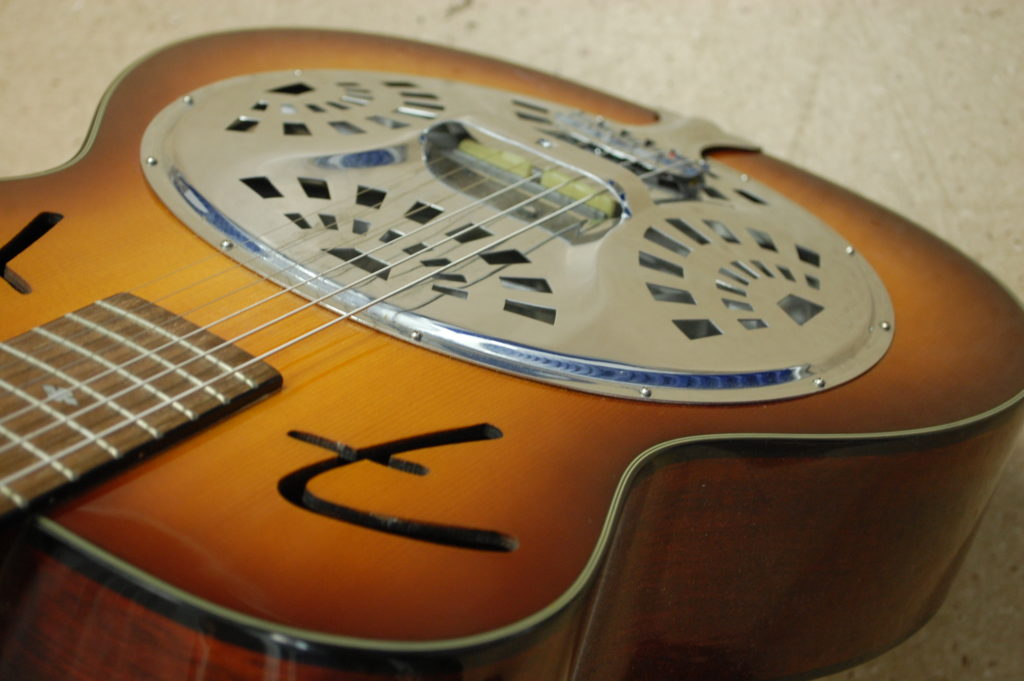



Squier Telecaster HS

Squier Telecaster Standard Series (2007)
S/N IC06082447
Rosewood fretboard, the usual bridge plate mounted single coil, neck humbucker.
Did I ever mention Steve Howe? The first Yes LP I heard was Relayer, and it turned out he was using a Tele almost exclusively on that album, but with the neck pickup changed from the rather anonymous (and underrated) single coil to a humbucker. Country it is not, but the twang is all over the three songs that got me hooked on Yes forever. Forty-five years ago, at the time of writing.
This Squier model beckoned to me at 4Sound in Karlstad, Sweden. Test played it, it was even better than expected, but I chose to return to the deep forest without it. Could not take my mind off it, so I had them send it to the freight terminal in Töcksfors (no extra charge, thanks for service!) where it was picked up. Plugging into the neat little Mini Twin from Arvika it still sounded more London 1975 than Danspartaj i Årjäng tjugo och sju. If there is such a thing.
Frankly, the weight, feel and sound of this is proof of Squier quality. This is hard to put down.



Squier Erikaster

Squier Erikaster 2007
Affinity Tele with maple neck and fretboard, standard electronics and bridge string anchoring. Body and headstock carved through and shaped by hand.
Test played for seven minutes; bring out the screwdriver and carving knife. After a large number of hours spent, a rather unusual instrument emerged, looking more grown into shape than factory made. Single cutaway and triple cutout; the most practical guitar ever for carrying. Gained a full page in Guitar Magazine, and the article was commented on by a guy I met at the local magazine dealer. Both music and guitar design was well received at art exhibition openings in Skien Art Society in February 2008, and in Kragerø Art Society in March.


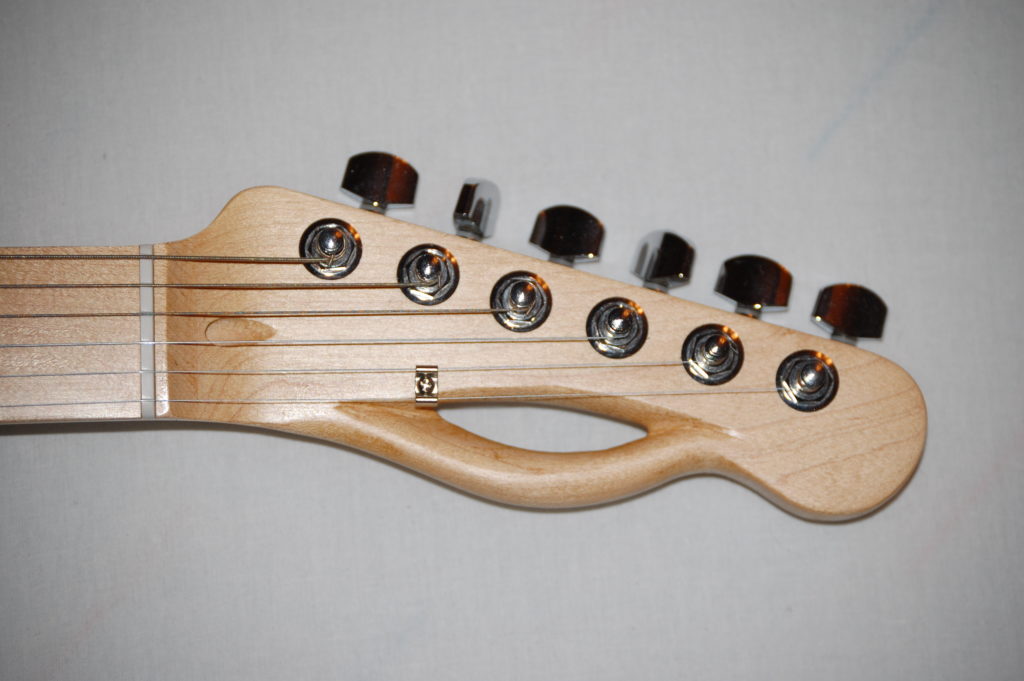
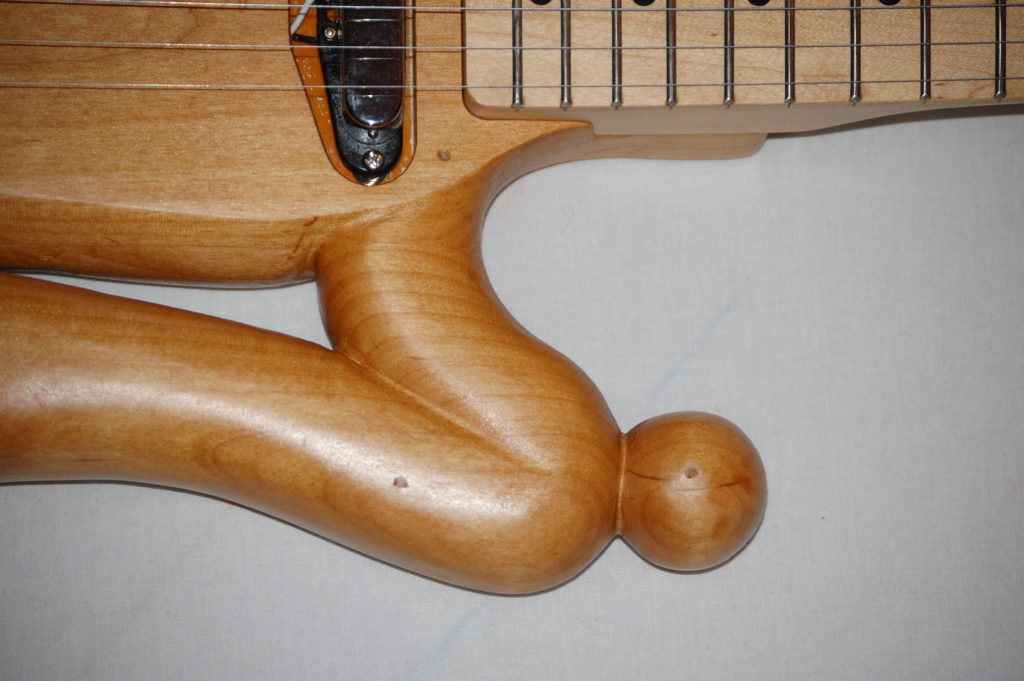

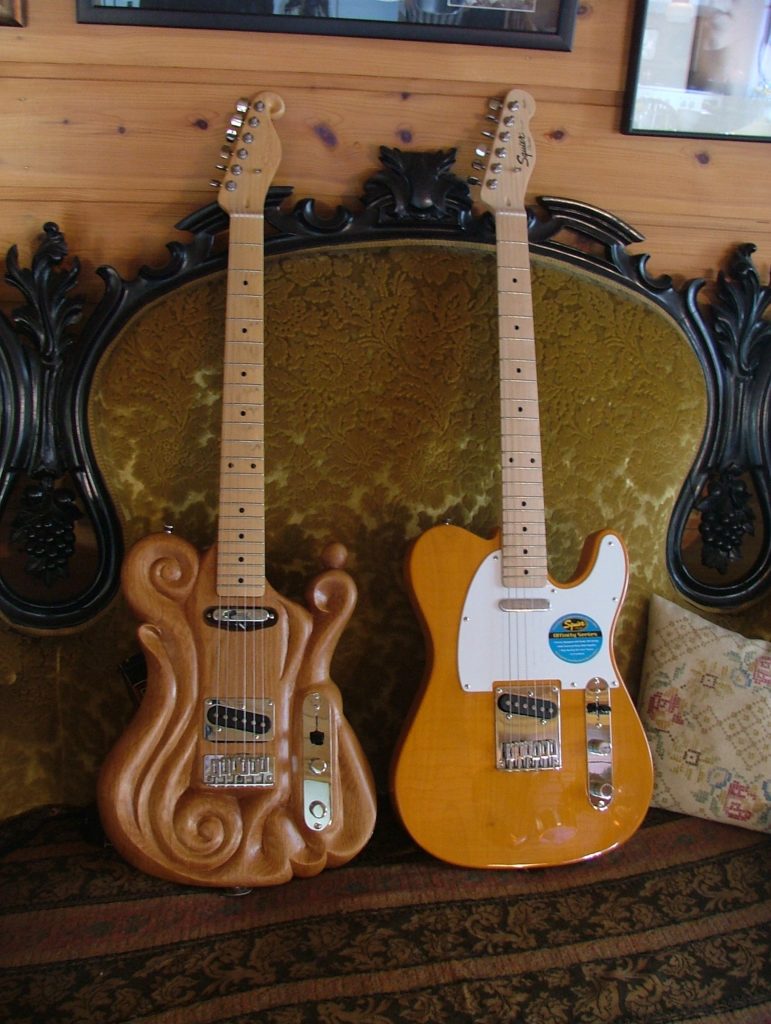
Fender Stratocaster Lefty

Fender Stratocaster Standard Left-Hand (2009)
MZ9384935
Standard Mexican left-hand model with maple neck and the usual electronics, set up for right-handed players by yours truly by flipping the nut, realigning the bridge and moving the strap button.
Whatever you want, Fender has it. “Standard” means (in 2009) assembled in Mexico, which implies quality parts put together by very able people. At half the price you get a guitar not inferior to American made products, the sound is at hand and I can find no faults in the craftsmanship. They say the difference is found in the time the woods is allowed to dry.
At fifteen I wanted to be Jimi Hendrix. I painted his face on my bedroom wall and wore a headband when I could. It took some years to realise it would never happen, and thirty-five years later I came to the conclusion that the nearest I would come, was owning a white maple Strat flipped over. Like he did. Looks great in the mirror, and the sound is close, even though this player’s ability isn’t. I have this theory, backed by Chas Chandler’s comment that he never could pick up Jimi’s gear as it just kept feeding back, that much of his technique was controlling the extreme sound level and letting notes through more than working to play them. Which of course doesn’t diminish his fantastic fluent playing on the clean songs.
At Kragerø Session 2009 I chose to do three acoustic and two electric songs, and this one handled the heavier stuff. With the Boss Loop Station I was able to take off a little on the solos on Anthem and Love Decides my Way, although a borrowed amp felt a bit restraining. It is always extremely satisfying to say the words “This is a song from my first album” in front of an audience.
The photo of me playing it is a selfie in a mirror. To be precise, a digitally flipped photo of a mirrored right-handed guitarist with a reversed left-handed guitar. Got it?


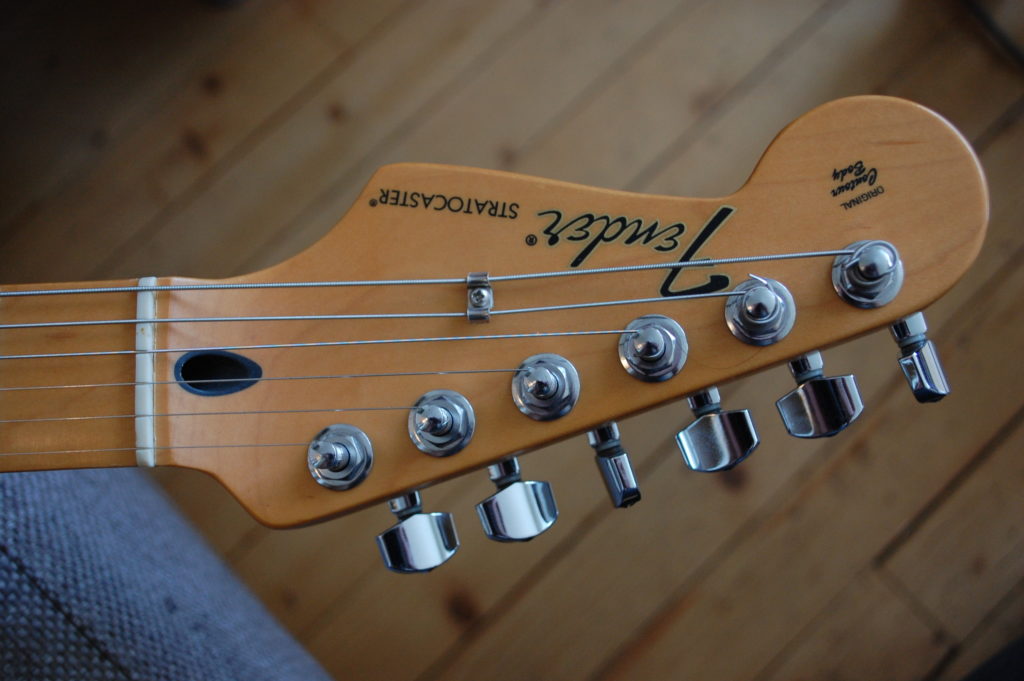



Fender Jaguar

Fender Jaguar 1994-95 (2009)
S032436, made in Japan
Fender’s second offset model (the Strat isn’t, you know) after the Jazzmaster. Shorter scale, two singlecoils with sawtooth surrounds (How to tell a Jag from a Jazz? The Jaguar has teeth), two circuits (rhythm and lead), vibrato.
I got a tax refund, and I was in need of some comforting after an encounter with that year’s virus, so I submitted a bid on eBay. As far as I knew I won the auction, but after paying there was total silence. Hello?? Nothing. Until a parcel arrived at my door two weeks later.
One knob needed fastening, and the initial setup was out there. Adjustments done, I found the scale length very inviting, and the controls are making perfect sense. I can go impromptu wild on one or two pickups on the solos, and be back at a soft, insistent rhythm at the flick of a switch. Goes extremely well with the Tubescreamer set to justalittlebit, the Champ, and the Loop Station for sensitive interplay.




Fender Jazzmaster

Fender Jazzmaster (2010)
Two Jazz pickups, two circuits, standard scale length, vibrato
The whole idea of relic/roadworn/vintage makes me shake my head and clutch my wallet. Is there such a thing as a mint relic? One point seems to be, you don’t have to worry about dings and dents.
I want a Jazzmaster.
There is a factory beaten up one for £1500, or a new spotless one for £700. Or, to beat the system, I could buy a second-hand one for £350. After browsing the whole of Denmark Street in London the visible result was a MIJ Candy Apple Jazz, properly played-in. Back at the hotel I borrowed a screwdriver, saving £75 on transporting it in two suitcases with a certain low-service airline.

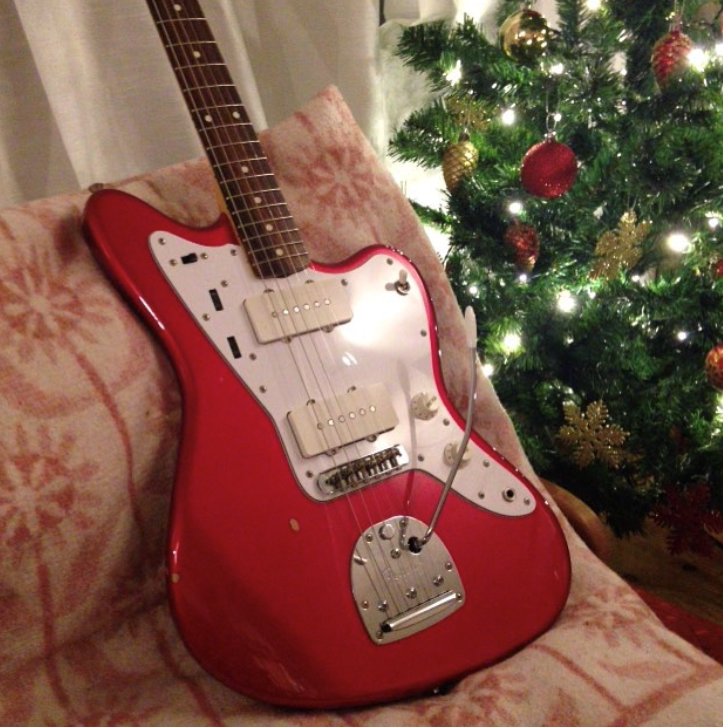






Squier Bass VI
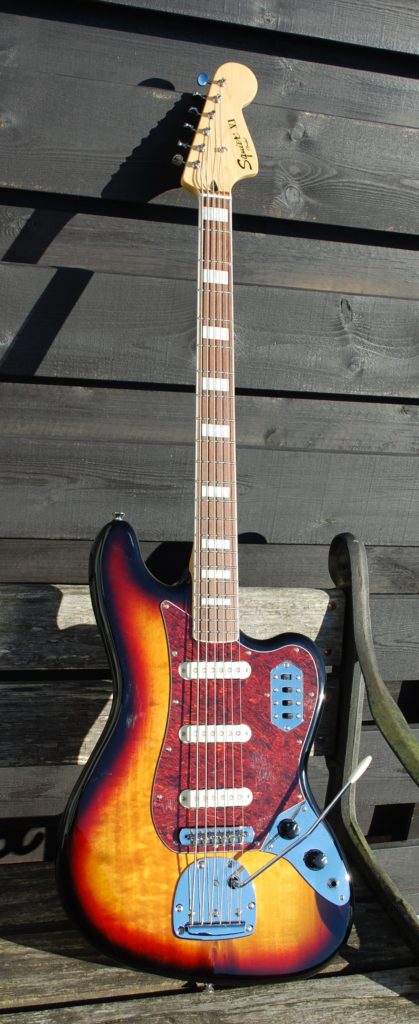
Squier Bass VI 2016 (2016)
Three single coils with on/off switches, tone switch (bass cut), vibrato.
Sitting solidly between the baritone and a regular bass, looking like a Jaguar after extensive sessions at the gym. Versatile and captivating; there are some good sounds in this one. Listen to Jørun Bøgeberg, he knows how to make the Bass VI sing. I had tried a Fender, the price was a little above budget, so this Squier was an obvious choice. In fact, it was so below budget that I ordered a Precision as well.



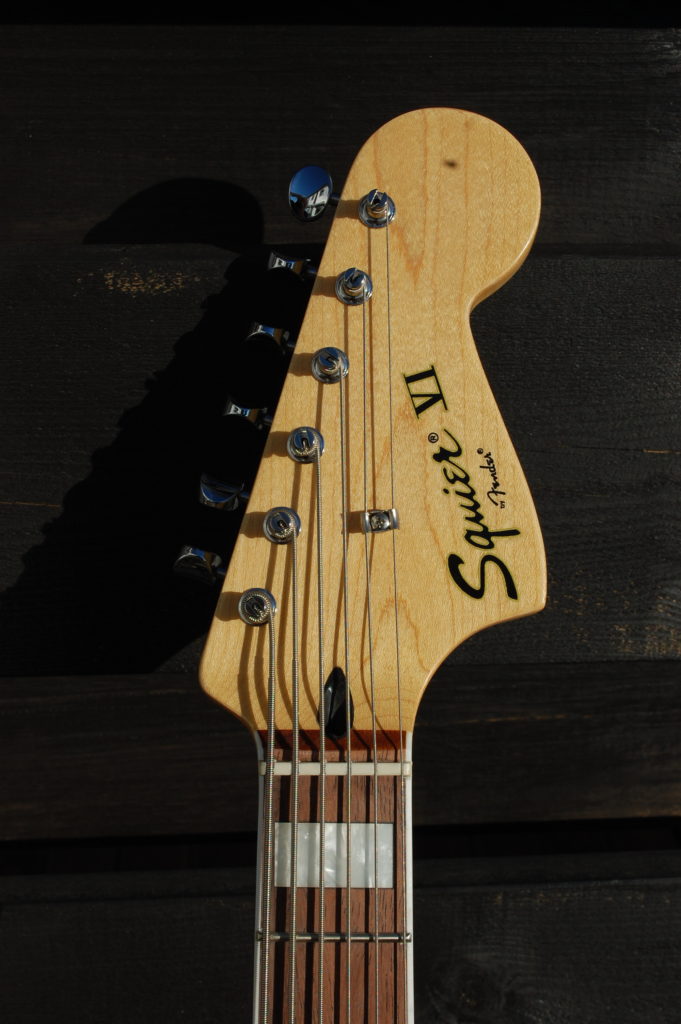


Squier Precision Fretless

Squier Precision fretless 2016 (2016)
One pickup, volume and tone. Fretless, yes, but marked where the frets would have been. A lot easier to navigate than the H&S doubleneck I had just sold, and a fraction of the weight. See previous entry for explaining why two basses are better than one, budget-wise. And note the difference between budget and cheap. There is nothing cheap about Squiers.




Fender Starcaster

Fender Starcaster 2018 (2018)
Apart from the bolt-on neck, the specs are all G, Two humbuckers, three-way switch, volume and tone for each. F-holes and centre block outs it firmly in 335 territory. The offset shape and six-a-side headstock is anchoring it in F-land.
Browsing ebay and other sites, some things tend to emerge more frequently. The Starcaster kept popping up. Interesting. Checking all the boxes, it remains to be tried. What luck I am going to Brighton to see Yes, and what coincidence they had one in store at GAK!
Early on the day of the show I drifted into the most red-and-yellow music shop I know. «Hi! I’d like to try the Starcaster.» «Well, we don’t seem to -» «You do. Your website says so.» It was in a storage somewhere, brought out after a timely break for lunch and a pint, and after checking it out with the appropriate Fender amp the decision was easy to make. I got a good deal on a sturdy Hiscox case as well, so we were ready to fly home the next day.
Yes were great. I am a big Jon Anderson fan, but a band featuring Steve and Alan will always get my attention. I got to talk to Steve and the new guys Billy and Jay after the concert, and got my copy of the Steve Howe Collection book signed by him. It’s quite worn and well-read; wonder how come… The Starcaster gets a good amount of playing time. I have never been the either-or kind of guy, so the mix of Fender and Gibson is confirming my theories of dialogue being the best way to achieve results. This is a good guitar.





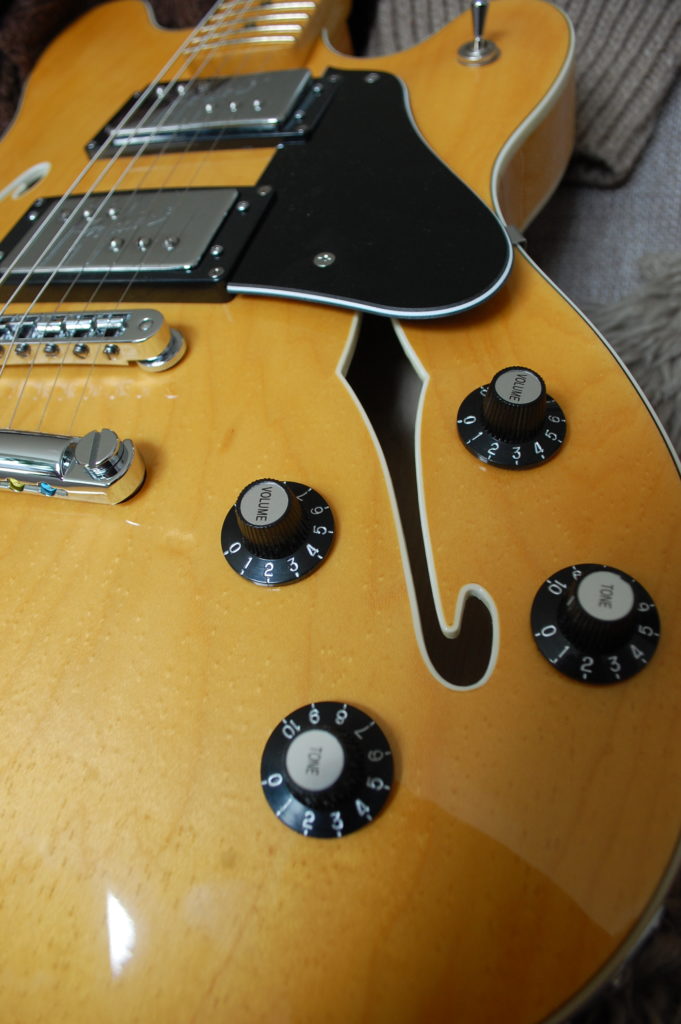
Fender Telecaster Thinline
Fender Telecaster Thinline 2007 (2018)
MZ7207424
Two humbuckers on an extended scratchplate, three-way switch, master volume and tone. These are routed from the back, so that the cap is not put on the top.
The Thinline was introduced in 1969, and the version with two Wide Range pickups was first seen in 1972. This incarnation was made in Ensenada, Mexico in 2007.
The Tele, considered to be perfect from the introduction, has nevertheless undergone some branching-out changes through the years. I have a Squier model with a humbucker at the neck; the next step is a double-humbucker thinline. Being a Gibson enthusiast I wanted to check out this one. Yet another find on eBay. Buy. Pay.
Then something seemed to be wrong on the seller’s end. Insufficient funds to pay for shipping. (What? I just sent you money for guitar AND shipping!) I checked the seller, and her other items were more pink blogger than punk blaster. Oh well.
Then the clouds cleared and she made her trip to the US post office. Excellently wrapped and delivered on time. I opened the parcel, a little warily as the description had said there was a photo of the Pope glued to the top, and I am not a Catholic. However, the Pope was easily freed from the lacquered alder or ash, and the top is now smooth as ever. Thank you, Maja; this is a keeper.





Fender Stratocaster

Fender Stratocaster USA 1978 (2023)
S897437
The timeless layout of three single coils, one volume, two tone, the five-way switch. 70s specs include bullet trussrod, large headstock, and three-bolt micro-tilt neck join. Actually, one bolt and two screws, and a smaller adjusting bolt.
Seventies Strats are underrated, even though build quality had dropped after the CBS takeover in 1965. Remember; when Jimi bought a new Stratocaster, it was – well, new in 1966 and the short years to follow. The basics were still there, and the micro-tilt is not a bad idea as long as the join is tight.
So twenty-three years after my first Strat, or even first Fender, here is the first US made.






Fender Telecaster Deluxe

Fender Telecaster Deluxe, USA 1978 (2023)




Fender galleries




A trio of offsets: Jazz, Jag and Bass VI


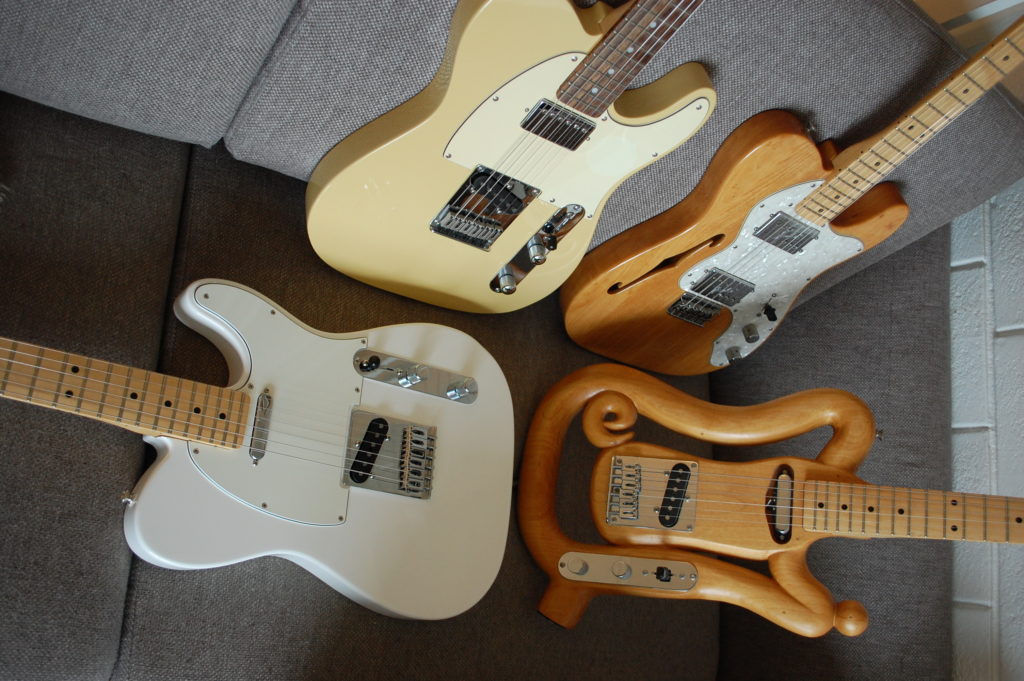

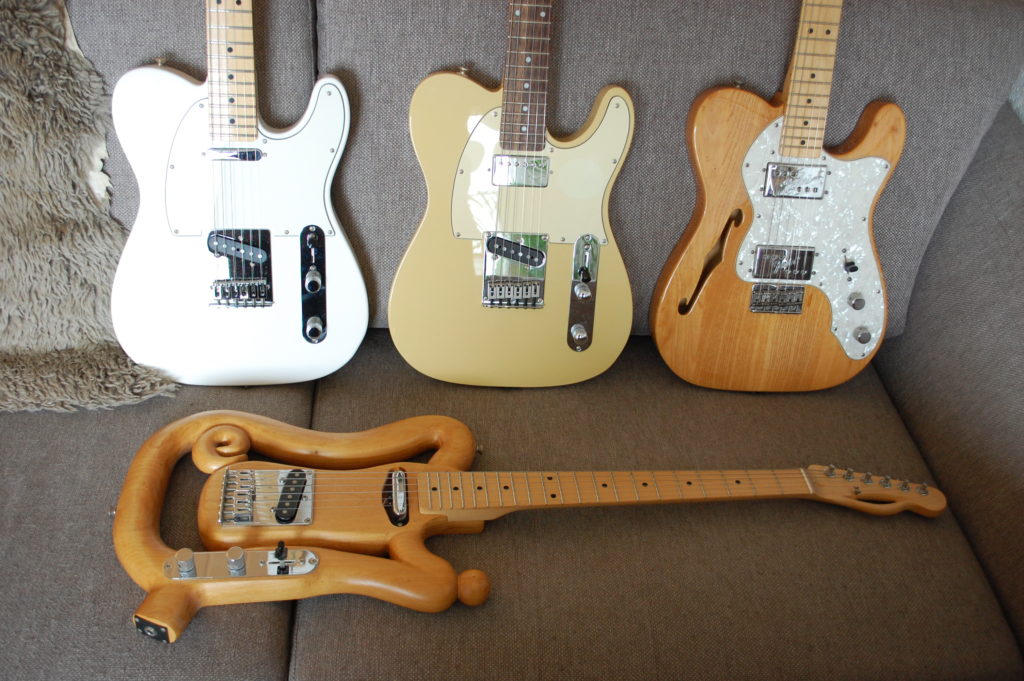
A quartet of Teles. Yep, the weird one, too. Squier Affinity Tele, hand-carved by myself and renamed the Erikaster.
The others are more traditional, from a Fender Player with the two single coils introduced seventy years ago, to the (underrated) neck SC replaced with a humbucker, and at last twin ‘buckers.
As usual the one I’m playing right now is the best, so it is no easy task to pick the ultimate combination. I’m a humbucker guy, but even then the original SC tele cannot be faulted. There are times when I forget the bridge pickup completely, and keep going on the neck.
In a different mood I keep changing between neck HB and bridge SC in quite the opposite way intended by both Leo and Les – I’ll put down some sharp chords from the bridge, and put some mellow soloing on top by way of the neck ‘bucker.
Or I’ll enter Gibson territory with the twin humbuckers, and appreciate that it still sounds like a Telecaster.
Tour
For Gibson territory, click here for tour, part 4: